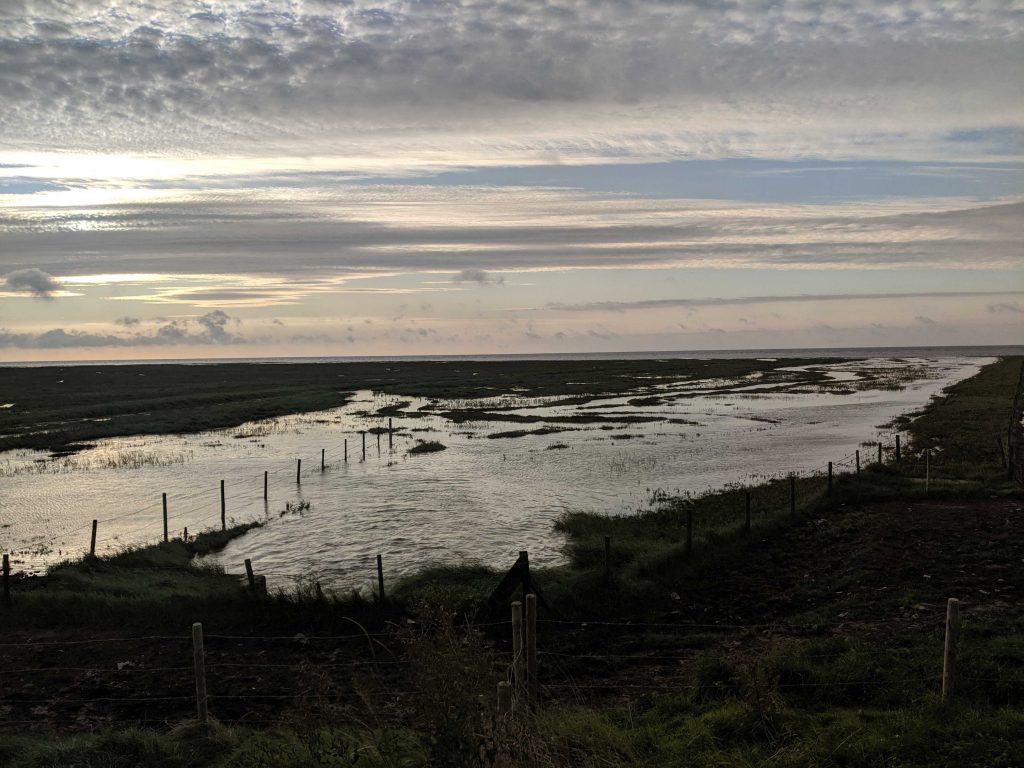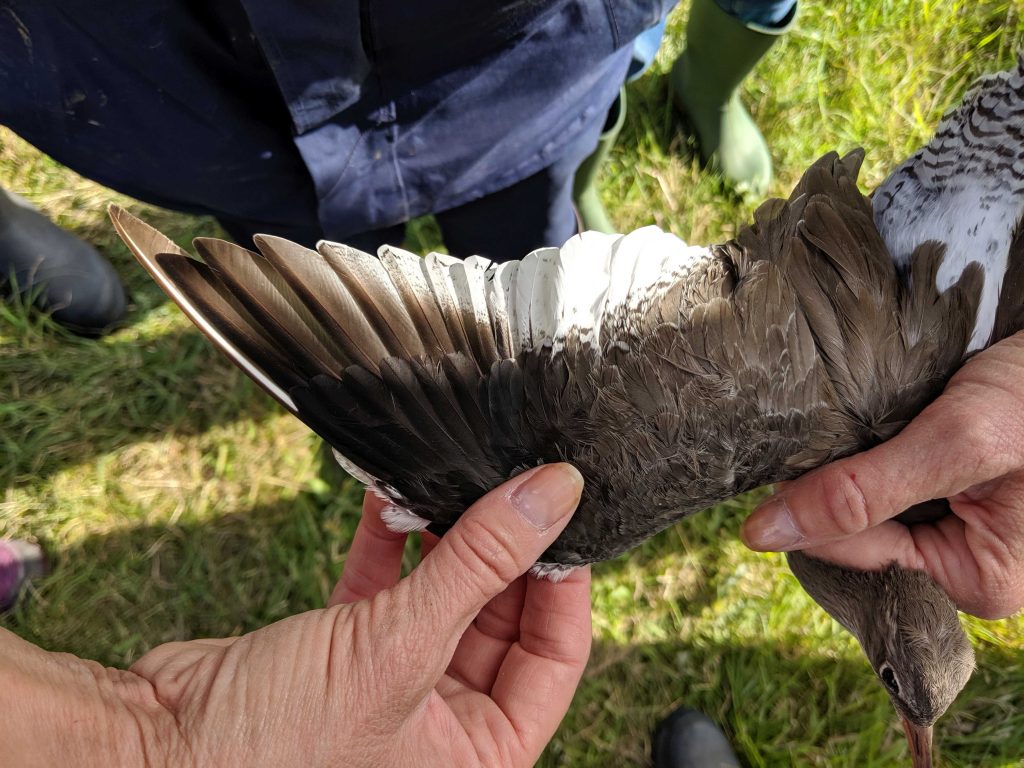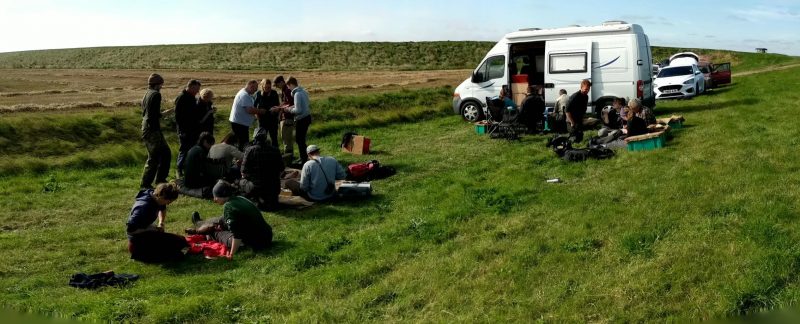Friday 30 August
Steve and Katharine undertook a recce of the area in advance of the team’s arrival. Horseshoe Lagoon had 160 Redshank while Friskney Island had a large flock of Knot which flew into the saltmarsh by the pool, which means it could be a potential mist netting option on a low spring set of tides.
In the early afternoon, two half nets were set on the southern corner of the Horseshoe Lagoon for Redshank (one large, one small mesh) for a catch later that evening. Upon arrival to the Lagoon, a group of 80 Redshank flew off, seemingly unrelated. Two nets (set as a clap-net pair) were set on the marsh south west of Horseshoe Lagoon (Wrangle Marsh) for Curlew following the Redshank setting with the intention to catch using this net the following morning.
Unfortunately, there was a failed attempt in that evening for Redshank as the birds were very skittish. There were up to several hundred near the nets, but few were catchable. There were some large groups of Knot using the Lagoon throughout the evening. The nets were left for a consolation attempt the following day, though it was suspected they would be partially wet. Once back at Friskney Hall, Steve gave a debrief for those who had newly arrived.

Saturday 31 August
The team were up and out to the Curlew nets at Wrangle Marsh at 04:40 and in position for 05:40. The southerly wind kept the tide down and birds tended to stay further out on the saltmarsh, not wanting to come into the catching area. As Steve had been speaking to Nigel about the team moving over to Norfolk side in the afternoon, we eventually fired on a consolation catch of four Curlew.
Wrangle catch totals
| Species | New | Retrap | Total |
| Curlew | 4 | 0 | 4 |
Those who had been out recceing returned and fed back that there were no viable options for the next day on the Lincolnshire side. The Redshank nets that had been set the previous day were then removed from the Horseshoe Lagoon and put out to dry during breakfast.
The Lincolnshire team then drove round to Norfolk and immediately joined the Norfolk team at Sandringham Estate to set nets on two fields for the following morning. The Lincs team strimmed the stubble field and set one pair of clap nets while the Norfolk team prepared the clover field and set two. Once completed, the two teams went to Snettisham to catch Sanderling which was a success, catching 71 birds (see Fieldwork August / September 2019 – Norfolk blog post).
Sunday 1 September
The two teams arrived at Sandringham at 04:45 and remained in their assigned groups in order to manage the two catching sites effectively. A number of godwit and Curlew immediately landed in the Norfolk field and they were promptly caught, while the Lincs team remained sitting should waders also land in theirs. They did, with up to 170 Curlew in the catching area, however due to the number caught on the other field, no catch was taken and the Lincs team joined the Norfolk team to help ring and process their catch. Afterwards, the team helped set the nets again, before departing for the Norfolk fieldwork base.
Gary and Tom had in the meantime had done a recce on the Lincolnshire side. Unfortunately, upon returning to his vehicle, Tom found out that it had been flooded due to the high tide.
Ryan, Louise, Gary, Will, Harry and Jenny formed a resighting team and went to Snettisham for the afternoon high tide. They sighted a good number of colour marked birds and enjoyed staggering views of Knot, godwit and other waders piling into the islands in the Snettisham Pits.
Monday 2 September
The two teams returned to Sandringham in the morning to their respective sites, barring Will and Graham who went and did recces on the Lincs side. Nigel’s team on the clover field made a small catch of Curlew and Black-tailed Godwits. The Lincs team stayed on standby watching to see if any birds would go into the catching area on the stubble field. A number of Curlew started landing in the field and Steve fired. The Lincs team assembled to ring, flag and process the birds.
After breakfast, Steve and Nigel discussed mist-netting options. Will had fed back to Steve that he’d surveyed 300 Redshank on the Horseshoe Lagoons. It was decided to split the Lincolnshire team with the majority staying in Norfolk to join them mist netting at Terrington.
Steve, along with Graham, Katharine, Adham (and Rachel who arrived a little later), went round to the Lincs side to set mist net and also set cannon nets on the Horseshoe Lagoon for Redshank the next morning. As the mist netting site was new, located on the marshes near the control tower, Steve told the team not be too disappointed if they only caught 10 birds, however 100 birds later….
Highlights included an adult Norwegian Barwit and a Swedish Dunlin. The team were in bed at Friskney Hall by 01:15.
| Species | New | Retrap | Total |
| Ringed Plover | 1 | 0 | 1 |
| Grey Plover | 2 | 0 | 2 |
| Knot | 28 | 0 | 28 |
| Dunlin | 25 | 1 | 26 |
| Bar-tailed Godwit | 32 | 6 | 38 |
| Curlew | 0 | 1 | 1 |
| Redshank | 10 | 0 | 10 |
| Turnstone | 1 | 0 | 1 |
| Black-headed Gull | 1 | 0 | 1 |
| 100 | 8 | 108 |
Tuesday 3 September
Steve and team got into position at 06:45 and within 15 min the first Redshank flew into the catching area, however they didn’t settle and moved away, possibly due to the presence of Grey Plover. The rest of the Lincolnshire and Norfolk teams joined them, arriving at 08:30.
A successful catch was made of small waders, however as the nets didn’t cover as much for the area as expected, it was a smaller amount than hoped. Overall though, it allowed some ofthe less experienced team members to get training in taking wader biometric measurements.

| Species | New | Retrap | Total |
| Knot | 15 | 0 | 15 |
| Dunlin | 21 | 0 | 21 |
| Redshank | 50 | 1 | 51 |
| 86 | 1 | 87 |
During breakfast, Steve and Nigel discussed options for Wednesday morning. He had seen a flock of 1,000+ birds knot on Snettisham Beach which could be an option, though with the wind as strong as it was forecast to be, they were thinking of needing larger nets.
As for the Tuesday evening, the Lincs team were going to be mist-netting on the Horseshoe Lagoons/Wrangle Marsh, while the majority of the Norfolk team were going to be at Terrington.
After a quick kip, the team tidied and vacated Friskney Hall at 17:30, subsequently heading to set up the mist nets before dusk. The Lincolnshire team separated into two groups to set up mist nets: some in the Horsehoe Lagoons and some on the Wrangle Marsh. Out on the Marsh, Steve led the group to set up nets, however the pool he had planned to set had disappeared, so after traversing some creeks, they were set up over a couple of different pools. Overall there were three lines of mist nets (1×5, 1×6, 1×9).
Lou kindly organised dinner which involved eating fish and chips on the sea wall at 19:40 before turning on the tapes at 20:20. It was quite windy, however the team still got a reasonable sized catch of waders with the highlights being a Whimbrel and Ruff. Once the nets were taken down and everything was processed, the team then had a late drive (or early depending on how you view it) to the Norfolk fieldwork base in order to be able to join up and try for the Sanderling catch in the morning.
| Species | New | Retrap | Total |
| Oystercatcher | 2 | 0 | 2 |
| Grey Plover | 5 | 0 | 5 |
| Knot | 9 | 0 | 9 |
| Dunlin | 10 | 1 | 11 |
| Bar-tailed Godwit | 7 | 2 | 9 |
| Redshank | 11 | 1 | 12 |
| Turnstone | 1 | 1 | |
| Whimbrel | 1 | 1 | |
| Ruff | 1 | 1 | |
| 47 | 4 | 51 |
Huge thanks to everyone who helped out with cooking at the Friskney Hall!

